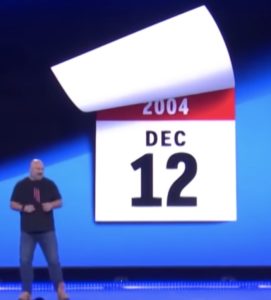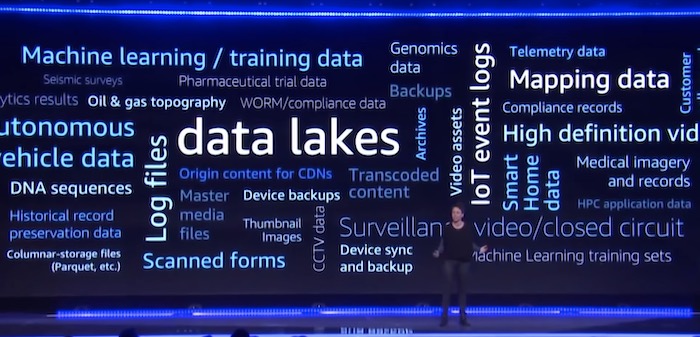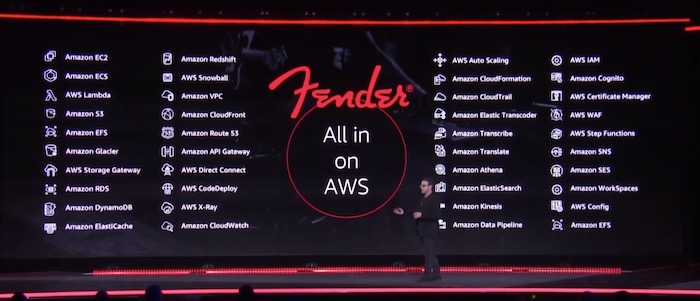AWS re:Invent 2014 was one of the high points of Werner Vogels’ life. At the end of the AWS CTO’s keynote at AWS re:Invent 2018, he noted that 2014 was the year that AWS launched AWS Lambda—as well as when world-famous DJ Skrillex headlined the AWS re:Play party. He didn’t say whether or not 2018 would linger in his memory the same way, but he did announce that Skrillex would be returning to rock the house again.
Leading up to that revelation, Werner spent almost two hours taking care of business: sharing a deep look at how AWS has built reliable, scaleable, and secure cloud systems, and dropping some pretty interesting feature and product announcements along the way. Here are 15 of the most resonant highlights from Werner's keynote, touching on a range of topics that included databases, Lambda and serverless, development and architecture tools, and more.
(For a full list of all the product announcements made during Werner’s keynote—which you can watch below—and during the rest of re:Invent check out this official AWS roundup.)
Considering the database
1. To open his talk this year, Werner asked Amazon Alexa where she thought he should start. “Why don’t you tell us about your worst day at Amazon?” she suggested. December 12, 2004, Werner replied, was his worst day ever at Amazon. It was the last day of that year for Amazon customers to qualify for Super Saving Shipping and have their packages arrive before Christmas.  However, a bug in the logging code took down Amazon’s customer database, and the company was “dead in the water”—for 12 hours! "This failure drives a lot of the development you see today from AWS," Werner said.
However, a bug in the logging code took down Amazon’s customer database, and the company was “dead in the water”—for 12 hours! "This failure drives a lot of the development you see today from AWS," Werner said.
2. "Things fail. Databases fail," Werner told the audience. Their, goal, he said, is to use reliability, scalability, and performance to minimize the impact and reduce the blast radius of those inevitable failures.
3. Cloud-native databases, Werner stated, are the foundation of innovation. The commercial enterprise databases most widely used until now, he said, were built for the ‘90s—not for how modern systems now operate.
4. Amazon's Items and Offers service—which supplies details like color and size about items on shopping pages—manages 100 billion records, with upwards of 5 billion updates per day. Using AWS Databases Migration Service, Amazon moved this data from 24 Oracle databases to Amazon DynamoDB, and the company continues to scale the service at least 30% - 40% per year.
5. Mai-Lan Tomsen Bukovec, Vice President of Amazon S3 and Amazon S3 Glacier, joined Werner on stage to discuss the architecture of S3, which Werner called “one of the digital wonders of the world.” S3 and Glacier, Mai-Lan said, manage exabytes of storage that hold tens of trillions of objects over millions of drives—supporting everything from data lakes to driverless cars. “In a single region,” Mai-Lan said, “S3 will manage peaks of 60 terabytes per second in a single day.” That’s why every feature or change gets a durability review, she said.
While the S3 team works hard to prevent the loss of a data center or “the long-term impairment of an availability zone,” AWS has never lost a data center. Nevertheless, AWS’ storage class “replicates storage across three availability zones,” Mai-Lan said. And the database for an availability zone (AZ) is not just in another room or on another floor of a data center—it's located, at the very least, in a separate building and often at a completely different location. That, she said, is true redundancy.
6. Alexa also asked Werner about his best day of the year. He replied that it was November 1st, which was the day Amazon shut down one of the world's largest data warehouses running on Oracle and moved it to over to Amazon Redshift (a reply that also teased the release of Amazon Redshift concurrency scaling).
Teaching guitar to the next Jimi Hendrix—one Lambda function at a time
7. Ethan Kaplan, chief product officer of Fender Digital, joined Werner to discuss how Fender uses dozens of AWS services to build applications and video tutorials that teach people how to play guitar. Since July, the software division of the iconic guitar maker has used 352 million AWS Lambda requests and is using AWS to store 747 TB of transcoded video. Fender is also using the Amazon SageMaker machine learning service to improve its factory guitar-building processes.
To celebrate, Ethan handed Werner—famously fond of EDM—a brand new, AWS-branded Fender Telecaster. "You give a guitar to a bass player," Werner said, “and they suddenly start wondering: six strings?"
Key thoughts on serverless
8. Why, Werner asked, are so many customers flocking to serverless? He answered this question with four key reasons:
- There's no infrastructure to provision.
- You pay for what you use, and you pay for direct value.
- It's very secure and highly available across multiple AZs.
- It scales automatically.
9. Enterprises, Werner stated, are driving the adoption of serverless. “Normally, we’d expect that the younger, tech-oriented businesses would be the first ones to try this out,” he said. “But what we’re seeing is that large enterprises are really the ones embracing serverless technologies. With serverless technologies, customers can build their business logic into their applications and not have to worry about maintaining anything else … This truly drives the evolution of serverless.”
10. It all started, Werner said, with AWS Lambda: “Four years ago,” he explained, “we pioneered the whole serverless movement by providing compute as a serverless environment as well, and we’ve seen enormous investment … and innovation over time.”
11. Werner described Amazon’s new Firecracker—which offers lightweight virtualization for serverless computing—as innovation at the micro-machine level to bring customers better isolation and efficiency in their serverless environments.
The right tools for the job you want to do
12. "You're very vocal about how you want to see the next generation of development happening," Werner told the crowd of cloud enthusiasts. “It’s really great to work together with you to really think of what modern development should look like.”
13. 95% of AWS services and features, Werner said, are based directly on customer feedback. Developers building in AWS, he added, have emphasized the importance of supporting their favorite integrated development environments (IDEs), languages, programming models, and workflows. To that end, Werner make a series of announcements:
- AWS tool kits for IDEs that focus on serverless development
- Ruby support for AWS Lambda
- Custom runtimes (via the new Lambda runtime API) for C++ and Rust, and for partner-supported languages including Cobalt, PHP, Erlang, and Elixir.
- Lambda Layers for centrally managing code shared across functions.
Making it easier to be well architected
14. "Are you well architected?" is a key question for the Werner Vogels experience. Unfortunately, the AWS Well-Architected Framework—a set of principles designed for companies to use before building their first cloud-based app—has not scaled the way Werner would have liked it to scale. To give it a boost, he unveiled the AWS Well-Architected Tool, which he hopes companies will use to review their workloads and architectures, and to compare them to the latest AWS best practices.
Werner Vogels—the Rick Steves of the cloud
15. Before leaving the stage, Werner unveiled Now Go Build, a long-form video series in which he travels the world visiting startups that do cutting-edge work using some the most interesting software powered by AWS. Episode 1—Jakarta is available now on YouTube.
Las opiniones expresadas en este blog son las del autor y no reflejan necesariamente las opiniones de New Relic. Todas las soluciones ofrecidas por el autor son específicas del entorno y no forman parte de las soluciones comerciales o el soporte ofrecido por New Relic. Únase a nosotros exclusivamente en Explorers Hub ( discus.newrelic.com ) para preguntas y asistencia relacionada con esta publicación de blog. Este blog puede contener enlaces a contenido de sitios de terceros. Al proporcionar dichos enlaces, New Relic no adopta, garantiza, aprueba ni respalda la información, las vistas o los productos disponibles en dichos sitios.






